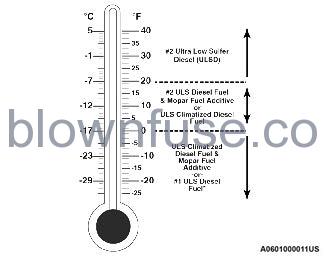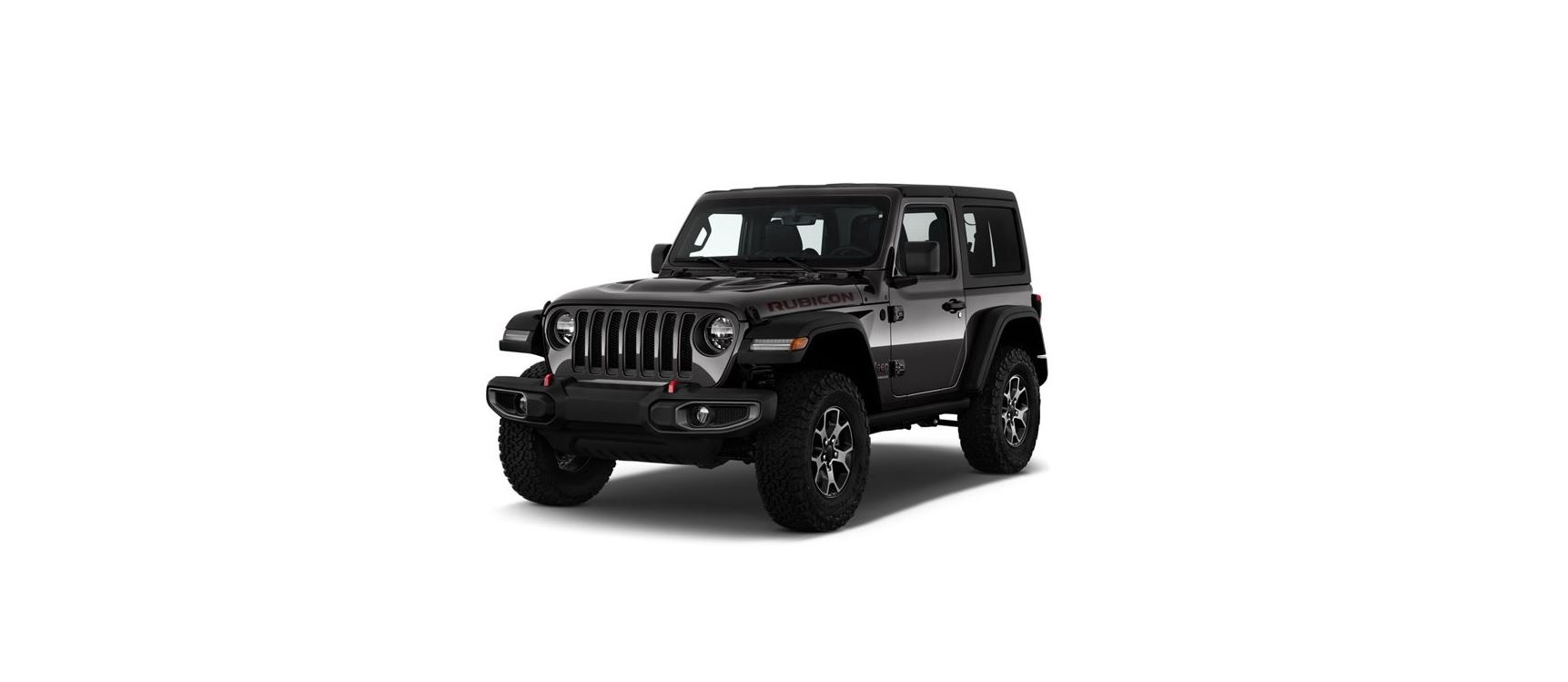2022 Jeep Wrangler Normal Operation (Diesel Engine)
 NORMAL OPERATION — DIESEL ENGINE
NORMAL OPERATION — DIESEL ENGINE
Observe the following when the diesel engine is operating:
- All message center lights are off.
- The Malfunction Indicator Light (MIL) is off.
- Engine Oil Pressure telltale is not illuminated.
- Voltmeter operation.
The voltmeter may show a gauge fluctuation at various engine temperatures. This is caused by the glow plug heating system. The number of cycles and the length of the cycling operation is controlled by the engine control module. Glow plug heater operation can run for several minutes. Once the heater operation is complete, the voltmeter needle will stabilize.
COLD WEATHER PRECAUTIONS
Operation in ambient temperature below 32°F (0°C) may require special considerations. The following charts suggest these options:
Fuel Operating Range
NOTE: Use Ultra Low Sulfur Diesel (ULSD) Fuels ONLY.
Fuel Operating Range Chart
Number 1 ULSD Fuel should only be used where extended arctic conditions of 0°F (-18°C) exist.
NOTE
- Use of Climatized ULSD Fuel or Number 1 ULSD Fuel results in a noticeable decrease in fuel economy.
- Climatized ULSD Fuel is a blend of Number 2 ULSD Fuel and Number 1 ULSD Fuel which reduces the temperature at which wax crystals form in the fuel.
- The fuel grade should be clearly marked on the pump at the fuel station.
- The engine requires the use of Ultra Low Sulfur Diesel Fuel. The use of incorrect fuel could result in engine and exhaust system damage page 420.
- If climatized or Number 1 ULSD Fuel is not available, and you are operating below 20°F (-6°C), in sustained arctic conditions, Mopar® Premium Diesel Fuel Treatment (or equivalent) is recommended to avoid gelling (see Fuel Operating Range Chart).
Engine Oil Usage
See Engine Fluids and Lubricants for the correct engine oil viscosity page 424.
Winter Front Cover
A Winter front or cold weather cover can be used in ambient temperatures below 32°F (0°C), especially during extended idle conditions. This cover is equipped with four flaps for managing total grille opening in varying ambient temperatures. If a Winter front or cold weather cover is to be used, the flaps should be in the fully open position to allow airflow to the cooling module and automatic transmission oil cooler. When ambient temperatures drop below 0°F (-17°C) the four flaps need to be closed. A suitable cold-weather cover is available from a Mopar® dealer.
Engine Warm-Up
Avoid full-throttle operation when the engine is cold. When starting a cold engine, bring the engine up to operating speed slowly to allow the oil pressure to stabilize as the engine warms up.
If temperatures are below 32°F (0°C), operate the engine at moderate speeds for five minutes before full loads are applied.
ENGINE IDLING
Avoid prolonged idling. Long periods of idling may be harmful to your engine because combustion chamber temperatures can drop so low that the fuel may not burn completely. Incomplete combustion allows carbon and varnish to form on piston rings, cylinder head valves, and injector nozzles. Also, the unburned fuel can enter the crankcase, diluting the oil and causing rapid wear to the engine.
STOPPING THE ENGINE
After full load operation, idle the engine for a few minutes before shutting it down. This idle period will allow the lubricating oil and coolant to carry excess heat away from the turbocharger.
NOTE: Refer to the following chart for proper engine shutdown.
| Driving Condition | Load | Turbocharger Temperature | Idle Time (min.) Before Engine Shutdown |
| Stop and Go | Empty | Cool | None |
| Stop and Go | Medium | 0.5 | |
| Highway Speeds | Medium | Warm | 1.0 |
| City Traffic | Maximum GCWR | 1.5 | |
| Highway Speeds | Maximum GCWR | 2.0 | |
| Uphill Grade | Maximum GCWR | Hot | 2.5 |
NOTE: Under certain conditions, the engine fan will run after the engine is turned off. These conditions are under high load and high-temperature conditions.
COOLING SYSTEM TIPS — AUTOMATIC TRANSMISSION
To reduce the potential for engine and transmission overheating in high ambient temperature conditions, take the following actions:
- City Driving — When stopped, shift the transmission into NEUTRAL (N) and increase engine idle speed.
- Highway Driving — Reduce your speed.
- Up Steep Hills — Select a lower transmission gear.
- Air Conditioning — Turn it off temporarily.
NOTE: If the coolant temperature is too high, the A/C will automatically turn off.
Do Not Operate The Engine With Low Oil Pressure
If the Oil Pressure Warning Light turns on while driving, stop the vehicle and shut down the engine as soon as possible. A chime will sound when the light turns on. After the vehicle is safely stopped, restart the engine and monitor the Oil Pressure Warning Light. If the Oil Pressure Warning Light is still illuminated, turn the engine OFF and contact an authorized dealer for further assistance. If the lamp is no longer illuminated, the engine can be operated but it is recommended to take the vehicle to an authorized dealer as soon as possible.
NOTE: Do not operate the vehicle until the cause is corrected. This light does not show how much oil is in the engine. The engine oil level must be checked under the hood.
CAUTION
If oil pressure falls to less than normal readings, shut the engine off immediately. Failure to do so could result in immediate and severe engine damage.
Do Not Operate The Engine With Failed Parts
All engine failures give some warning before the parts fail. Be on the alert for changes in performance, sounds, and visual evidence that the engine requires service. Some important clues are:
- Engine misfiring or vibrating severely
- Sudden loss of power
- Unusual engine noises
- Fuel, oil or coolant leaks
- Sudden change, outside the normal operating range, in the engine operating temperature
- Excessive smoke
- Oil pressure drop

